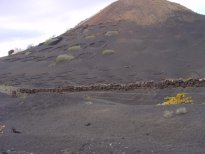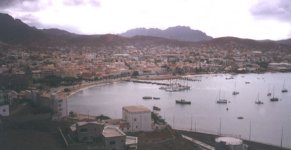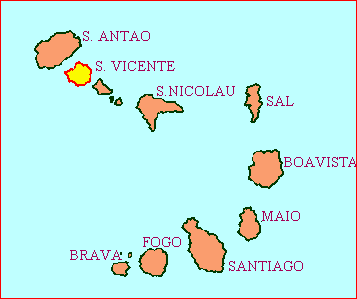|
We last wrote as we were about to leave Vilamoura, bound for Lanzarote and hoping to move fast enough to
avoid strong head winds from the south east as we approached the
Canaries.
We sailed out of Vilamoura harbour at about 3 in the afternoon on 13th October, waved off by our generous
hosts, Sam and Audrey, and Emma, a fellow house guest. It was quite a shock going from the great comfort of
life fully ashore straight into a pretty rolly sea. It always gives you pause for thought when someone in
the harbour or marina asks where you're going, and goes quiet on hearing the answer! Also, the Met
Office in Bracknell had told us that on the day before we left, a reasonable sized ship had delayed its
departure from Lisbon due to the swell! But they also reassured us that it was reducing fast … and we were
determined to avoid those south westerlies later on, if we possibly could. So a fairly rough first night
was followed by the forecast decrease in both sea and wind, and we had to motor for a while to keep up our
speed towards the invisible weather front. We made good progress, but as we approached the key point, the
wind started to move westwards. But on our third night out, John was on watch when a ship he had been
tracking "disappeared", and he switched on the radar to find us alarmingly apparently heading fast for a
large island (not on the chart). This was the front, in the form of a rain
squall and gusts of wind, and
then it cleared and the wind settled down to its "normal" north easterly direction.
For the non-sailors among you, I should explain that sailing into the wind, as we would have been had we
had a south westerly, is frequently a relatively slow and uncomfortable way to sail. Murphy's Law dictates
that you can't sail the course you want, but have to tack or zig zag across the wind to make progress; the
sea is rougher; and the wind is stronger by one or more Beaufort force because you are sailing into it.
So on the whole, when you can avoid it, you do! Our entire route has evolved over generations of mariners,
and is timed to be largely down wind (with the wind behind us). This presents its own challenges, not
least that it tends to be a very rolly point of sail and for passage making with few crew, as we are,
requires sailing techniques that one does not normally use. For short passages, we tend to use one of three
spinnakers we were fortunate to buy with Flame from her racing days, but with only two on board, they are
hard to handle when the wind rises much.
This passage was our first real opportunity to try out our "trade wind rig" of twin foresails, set in front
of the mast one on each side of the boat, and no mainsail (behind the mast). It worked wonderfully,
and it was a fantastic feeling to enjoy the power of the two sails pulling us through a starlight night on
our last night out before Lanzarote. The nights were dark, lit initially by stars and phosphorescence in
the water, till a bright moon came up. After sailing in the Mediterranean and the channel, the absence of
planes in the sky was remarkable. The following afternoon John saw turtles swimming past at great
speed, and then later we spotted the off-lying islands to the north of the
Lanzarote, but it took us till midnight to sail down to Arrecife, the main safe harbour and main town on the island. We felt our way
gently into the outer harbour and dropped an anchor to wait till the morning before finding our final
anchoring spot for the next three weeks.
It was our intention for this to be our final preparation for the Atlantic crossing, as a reasonable
place to find boat bits and pieces and also to complete the victualling.
We found ourselves one of only two English boats in a harbour quite full of cruising yachts mostly from
Australia and New Zealand, who are starting on the home leg, as it were. This was the moment when we
felt our trip was really beginning, as we were surrounded by sailors bent on the same or similar
objective as ourselves. (The Portugese trades, from the north east, are such that the saying goes that the
best way back from the Canaries to Europe is via the Caribbean!)
We were fortunate to meet some really nice fellow cruisers, who inducted us into the radio networks, and
gave us many tips and suggestions for places to go on our way back, routes to take, and so on.
It was here that we decided, based partly on reading the pilot book more closely, and partly on reports via
other yachties in the harbour, to sail down to the Cape Verdes and leave for Martinique from there. This
reduces the length of the Atlantic crossing; should mean you start in the trade winds belt, instead of
having to sail to find it; and not least importantly was reputed to have a good fresh vegetable market,
which sadly is no longer the case in Arrecife.
|
|

|
We did manage to see a little of the island, and were
most of all fascinated by the extraordinary method of growing vines in hollows, some as much as 6 foot deep,
surrounded by small dry stone walls, to protect the plants from the constant strong winds.
From Arrecife we made a short day sail down to an anchorage on the south of the island, partly designed
to test out our French wind vane self steering, which for various reasons, we had so far not managed to get
properly to grips with. We had reasonable success, and christened her Cecile. (The electric autopilot is
unimaginatively called George).
|
The following day we set sail for the south of Gran Canaria, to shorten the sail to the Cape
Verdes, and Cecile withdrew co-operation. On the other hand, it was difficult conditions for her, with first very
little wind, then, as it got dark, a squall and too much wind (it always seem to happen just after it gets
dark!), so we made excuses for her, let her off, and let George do the work, as our batteries were in a
good state of charge (he is rather elderly as autopilots go and uses a lot of power).
We approached the south of Gran Canaria the following morning, warned in the sailing directions of known
wind acceleration zones. Trying to make a positive visual identification of the point we were heading
for, we noticed a lot of tall white masts, which as we came closer turned into a massive wind farm, so we had
pretty good warning of where the acceleration zone was! We were given the only spare spot in a lovely
quiet small marina/harbour called Pasito Blanco, just west of Maspalomas. Two days later, we set out for the Cape
Verdes, back through the acceleration zone, which was quite rough and seemed to extend a long way. We discovered from a
radio contact with our new New Zealand friends on Just Magic, that there was a radio net in operation for
boats sailing down to the Cape Verdes. Essentially, this is an exchange of position, weather and general
progress between a group of yachts. Some are run by one individual over long periods, others, as with this
one, are more ad hoc, run by the yachts themselves. It is nice to hear other voices and to hear of other
people's progress and dramas, and not to feel you are totally alone.
We had hand steered the first night, not wanting to use up battery power, and feeling that the conditions
would not suit our still tentative efforts with Cecile. Then we managed to get her going and she
steered quite well for us for about 36 hours, with a very reduced sail are due to the conditions, which
were still quite windy - between 20 and 30 knots true. Once the wind started to drop and we put more sail up
however, she withdrew co-operation, and later we heard on the radio that France was in the throes of a
general strike (which included the shipping forecasters!), and it was clear that Cecile had joined
them. We spent a very tiring next two days spending all day trying to get her to steer, alternately
coaxing and threatening, meanwhile steering ourselves all the time and of course through the nights. On the
second of these nights we turned the engine on, not to motor but to allow us to run George for a brief period
of respite, and then we abandoned attempts with Cecile and just concentrated on sailing the boat as fast as
we sensibly could. Although this is also tiring, settling into a routine of steering, sleeping, eating
and a little navigation and radio work proved easier, because we could catch up on sleep during the day,
instead of constantly working on Cecile and trying out different sail combinations for her. And it did
provide some exhilarating sailing, surfing down the waves - up to 10 and a half knots once! - foaming
water hissing all round the boat
But we were pleased nonetheless to arrive off the islands, where Barry and Annette of Just Magic, having
arrived a couple of days earlier, very kindly talked us into the harbour at midnight and then guided us by
signalling lamp into an excellent smooth anchorage near them. While one can generally get into many
harbours on one's own, the navigation lights never seem to be as bright as the shore lights - even the
streetlights, so it always an uncertain and very slow process as one feels one's way slightly nervously in.
The alternative is to slow down on the approach and wait for dawn, but that means another night at sea,
which is not generally relished by that stage! So help like theirs was a fantastic welcome to the
cruising community.
They continued in the same vein, with Barry offering help with his great technical expertise (he and
Annette built Just Magic, a beautiful GRP boat, themselves) to fibreglass a creaking bulkhead, which
had been driving us mad by creaking loudly every time we rolled - about every 30 seconds! - and to interpret
and implement the fax instructions which finally arrived from France to alter a part of Cecile which
they appear to have wrongly manufactured …
Once we have established that we have her working, we will pursue that one a little further!
Meanwhile, we have seen a little of Mindelo, the second largest "city" in the Cape
Verdes, on Sao Vincente - one of the northern most islands. The people are very friendly, fairly poor, and here in
Mindelo, there is concern about the security of one's yacht if left unattended after dark, or one's
dinghy which seems to need guarding by a boat boy. People coming straight from Britain find this outrageous,
though we are advised by our New Zealand friends that the boat boys here are very reasonably behaved and not
aggressive or pushy, so it seems to be a matter of perspective and prior experience. We are hoping to
get ashore to see a little of the hinterland, but again the question of leaving the boat for any length
of time is a concern, and we are the last to leave of our trusted group in the anchorage, and now surrounded
by French yachtsman, who, sad to say, have themselves not a good reputation for honesty. It's always hard
to know how much these things are exaggerated, but you would feel silly to ignore them and then suffer the
consequences!
|
Mindelo, Sao
Vincente,
Cape Verde Islands
|
 |
Anyway, we have decided to make for Martinique in the French Antilles, because,
French yachtsman or no, we think we may feel in need of a little civilisation by
then, and the food is reputed to be far better than in the ex-British islands!
We plan to depart some time around 2nd December, and all being well, expect this passage to take about 16
days, so should be there in time for Christmas. But in case (!) I am slow with the next update, let me
wish you a very merry Christmas.
John &
Helen Fleming
Flame of Gosport
30 November 2000
|
| The Cape Verde Islands
|
 |
 |
Return to Home Page |
 |
Next bulletin -
30th December 2000 |
 |
Previous bulletin -
13th October 2000 |
 |
Ship's Log
Index |
|
|